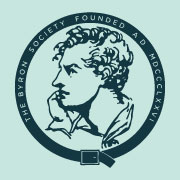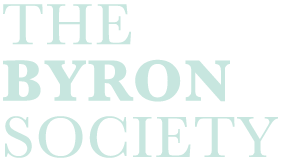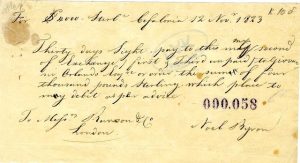Dr Christine Kenyon Jones and Professor Roderick Beaton discuss the discovery of a vital fragment of Byronic history.
29th April 2021
Members of the Byron Society have helped to identify an important document demonstrating Byron’s generosity and commitment to Greece in November 1823.
The news was published in the Observer and its sister-paper the Guardian, and then also in The Times, to mark the 197th anniversary of Byron’s death on 19 April.
The document, discovered by Helena Smith, the newspaper’s Athens Correspondent, in the Greek state archives, appears to be a cheque for Byron’s payment of £4,000 (some £332,000 in today’s money) to representatives of the precarious Provisional Government of Greece in November 1823.
Helena turned to BS Committee member, Professor Roderick Beaton, author of Byron’s War (2013), for comments about the document’s context and significance. Byron’s willingness to part with such a large slice of his personal fortune was crucial, Professor Beaton said, and helped change the course of events in Greece. ‘No historian of the war has really paid attention to this fact,’ he added, ‘but the Ottoman Albanian troops who were besieging Missolonghi suddenly disappeared as soon as word got out that Byron had lent this money.’
Helena turned to BS Committee member, Professor Roderick Beaton, author of Byron’s War (2013), for comments about the document’s context and significance. Byron’s willingness to part with such a large slice of his personal fortune was crucial, Professor Beaton said, and helped change the course of events in Greece. ‘No historian of the war has really paid attention to this fact,’ he added, ‘but the Ottoman Albanian troops who were besieging Missolonghi suddenly disappeared as soon as word got out that Byron had lent this money.’
In Byron’s War, Professor Beaton describes how Byron met the Greek government deputies in the quarantine station in Cephalonia in November 1823 and agreed to make the large personal loan (which was intended to be redeemed when the loan sought by the Greek government from private speculators in London came through). Against the advice of Colonel Charles Napier, the British ‘Resident’ or governor of Cephalonia, Byron agreed to lend 20,000 Spanish dollars, equivalent to £4,000, from his personal fortune and, as Professor Beaton says, at a stroke proved wrong the cynical speculations of Trelawny, and perhaps others, about the depth of his commitment to the Greek cause.
The document was also examined by Professor Paul Curtis, who has transcribed some 400 of Byron’s letters, many for byrononlineproject.com, and by myself, in order to advise on its authenticity. We concluded that the main text was written by another hand but had been corrected by Byron, who seems have altered ‘may’ to ‘my’ twice; deleted the ‘s’ on the end of ‘sums’ and added his ‘Noel Byron’ signature.
Geoffrey Bond, former Chairman of the Byron Society and co-author of Dangerous to Know: Byron and His Portraits, added a note to explain how Byron, who had been a lavish spender in his youth and had been in debt for many thousands of pounds, could afford to make such a large loan. ‘In 1817 he had sold Newstead Abbey for some £94,000 (more than £5 million in modern money), and in 1823 he had also received over £11,000 from the sale of his property in Rochdale, and £4,000 from his father-in-law Sir Ralph Noel as a belated part of Lady Byron’s marriage portion. This meant that he was able to support liberal causes such as the Italian Carbonari and then the fight for the freedom of Greece’.
If you would like to read the full article, it is available on the Guardian website, here.


